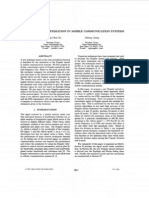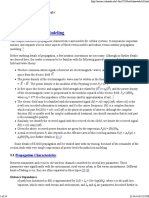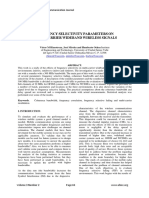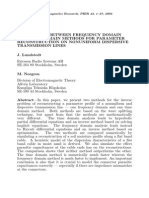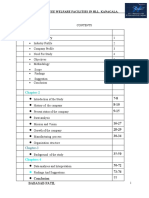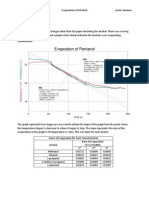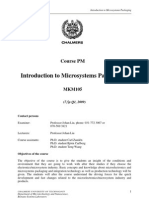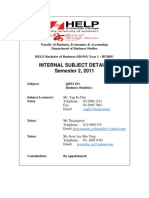CSP Lab Manual 25.2.16
CSP Lab Manual 25.2.16
Uploaded by
prashanthCopyright:
Available Formats
CSP Lab Manual 25.2.16
CSP Lab Manual 25.2.16
Uploaded by
prashanthOriginal Description:
Original Title
Copyright
Available Formats
Share this document
Did you find this document useful?
Is this content inappropriate?
Copyright:
Available Formats
CSP Lab Manual 25.2.16
CSP Lab Manual 25.2.16
Uploaded by
prashanthCopyright:
Available Formats
G.
PULLAIAH COLLEGE OF ENGINEERING AND TECHNOLOGY
PASUPALA (V), NANADIKOTKUR ROAD, KURNOOL-518002
G.PULLAIAH COLLEGE OF ENGINEERING & TECHNOLOGY: KURNOOL
DEPARTMENT OF ELECTRONICS AND COMMUNICATION ENGINEERING
M.Tech. (DECS) II SEMESTER
COMMUNICATIONS & SIGNAL PROCESSING LAB
LIST OF THE EXPERIMENTS:
1. Simulation Rayleigh Fading Channel Using Either Clarkes Model or Jakes Model for
Different Doppler Spreads (Ex. 50 Hz and 100 Hz).
2. Generation of Maximal Sequences and Gold Sequences.
3. Design and Simulation FIR Filter Using any Windowing Technique.
4. Design of IIR Filters from Analog Filters.
5. Performance Evaluation of QPSK System over Gaussian AWGN Channel.
6. Performance Evaluation of QPSK System over Rayleigh Fading Channel.
7. Performance Evaluation of RAKE Receiver over Slow Fading Channel.
Page No: 1
G.PULLAIAH COLLEGE OF ENGINEERING AND TECHNOLOGY
PASUPALA (V), NANADIKOTKUR ROAD, KURNOOL-518002
1. Rayleigh Fading Channel By Using JAKES or CLARKES Model
Aim:- To Simulate the Rayleigh Fading Channel using Jakes Model for different
Doppler Spreads (ex:50Hz and 100Hz).
Software Required:- Pc with MATLAB R2010a
Theory:Rayleigh fading is a statistical model for the effect of a propagation
environment on a radio signal, such as that used by wireless devices.
Rayleigh fading models assume that the magnitude of a signal that has passed
through such a transmission medium (also called a communications channel) will
vary randomly, or fade, according to a Rayleigh distribution the radial component
of the sum of two uncorrelated Gaussian random variables.
Rayleigh fading is viewed as a reasonable model for tropospheric and
ionospheric signal propagation as well as the effect of heavily built-up urban
environments on radio signals. Rayleigh fading is most applicable when there is no
dominant propagation along a line of sight between the transmitter and receiver. If
there is a dominant line of sight, Racian fading may be more applicable.
Rayleigh fading is a reasonable model when there are many objects in the
environment that scatter the radio signal before it arrives at the receiver. The Central
limit Theorem holds that, if there is sufficiently much scatter, the channel impulse
response will be well-modeled as Gaussian process irrespective of the distribution of
the individual components. If there is no dominant component to the scatter, then
such a process will have zero mean and phase evenly between 0 and 2 radians. The
envelope of the channel response will therefore be Rayleigh.
Calling this random variable R, it will have a probability density function.
Where = E(R2).
Often, the gain and phase elements of a channel's distortion are conveniently
represented as a complex number. In this case, Rayleigh fading is exhibited by the
assumption that the real and imaginary parts of the response are modelled by
independent and identically distributed zero-mean Gaussian processes so that the
amplitude of the response is the sum of two such processes.
Page No: 2
G.PULLAIAH COLLEGE OF ENGINEERING AND TECHNOLOGY
PASUPALA (V), NANADIKOTKUR ROAD, KURNOOL-518002
JAKES Model Diagram:Jakes'
model:-
Jakes
popularized a model for Rayleigh fading based on summing sinusoids. Let the
scatterers be uniformly distributed around a circle at angles n with k rays emerging
from each scatterer. The Doppler shift on ray n is and, with M such scatterers, the
Rayleigh fading of the kth waveform over time t can be modeled as: .
Here, and the and are model parameters with usually set to zero, chosen so that
there is no cross-correlation between the real and imaginary parts of R(t): and used
to generate multiple waveforms. If a single-path channel is being modeled, so that
there is only one waveform then can be zero. If a multipath, frequency-selective
channel is being modeled so that multiple waveforms are needed, Jakes suggests that
uncorrelated waveforms are given by: .
In fact, it has been shown that the waveforms are correlated among themselves
they have non-zero cross-correlation except in special circumstances. The
model is also deterministic (it has no random element to it once the parameters are
chosen). A modified Jakes' model chooses slightly different spacing for the scatterers
and scales their waveforms using Walsh-Hadamard sequences to ensure zero crosscorrelation. Setting
And, Results in the following model, usually termed the Dent model or the modified
Jakes model:
Page No: 3
G.PULLAIAH COLLEGE OF ENGINEERING AND TECHNOLOGY
PASUPALA (V), NANADIKOTKUR ROAD, KURNOOL-518002
The weighting functions Ak(n) are the kth Walsh-Hadamard sequence in n.
Since these have zero cross-correlation by design, this model results in uncorrelated
waveforms. The phases can be initialized randomly and have no effect on the
correlation properties. The Fast Walsh transform can be used to efficiently generate
samples using this model.
The Jakes' model also popularized the Doppler spectrum associated with
Rayleigh fading, and, as a result, this Doppler spectrum is often termed Jakes'
spectrum.
Program:%Jake's model%%
clc;
clear all;
N0=8;
N=2*(2*N0+1);
t=250*10^-3;
t1=0:t/(2500):t;
fm=input('enter the Doppler spread frequency fm=');
wm=2*pi*fm;
gamma=1;
fc=900*10^6;
pw1=0;
for s=0:(t/(2500)):t;
xca=0;
xsa=0;
i=1:N0;
wn=wm.*cos(2*pi*i/N);
bt=(pi*i/N0);
for i=1:N0;
x=cos(wn(i)*s);
xca=xca+x.*2*cos(bt(i));
xsa=xsa+x.*2*sin(bt(i));
end
x1=0.707*cos(2*pi*fm*s);
x1ca=x1*2*cos(gamma);
x1sa=x1*2*sin(gamma);
xc=xca+x1ca;
xs=xsa+x1sa;
y=xs.*sin(2*pi*fc*s)+xc.*cos(2*pi*fc*s);
%disp(y)
z=y.^2;
pw=10*log10(z);
pw1=[pw1 pw];
end
%disp(pw1);
plot(pw1(2:length(pw1)));
title(' Rayleigh fading channel by using Jakes model');
xlabel('samples');
Page No: 4
G.PULLAIAH COLLEGE OF ENGINEERING AND TECHNOLOGY
PASUPALA (V), NANADIKOTKUR ROAD, KURNOOL-518002
ylabel('power (db)');
% axis([0 120 -50 20]);
grid;
Output results:enter the Doppler spread frequency fm=100Hz
CLARKES MODEL FOR DIFFERENT DOPPLER SPREAD
Page No: 5
G.PULLAIAH COLLEGE OF ENGINEERING AND TECHNOLOGY
PASUPALA (V), NANADIKOTKUR ROAD, KURNOOL-518002
Spectral shape due to Doppler spread in Clarkes model:
Developed
spectrum analysis for Clarkes model. Let P ()d denote the function of the total
incoming power with in d of the angle and let A denote the average received
power with respect to an isotropic antenna . As N, P () d approaches a
continuous, rather than a discrete ,distribution . If G ( ) is the azimuthal gain
pattern of the mobile antenna as a function of the angle of arrival, the received
power can be expressed as
Pr=A G( ) P()d
The spectrum is centred on the carrier frequency and is zero outside the limits
of
fcfm. Each of the arriving waves has its own carrier frequency (due to its
direction of arrival) which is slightly offset from the center frequency .For the case
of a vertical /4 antenna (G( )=1.5) and a uniform distribution P()=1/2 over 0 to
2 output spectrum is given by
SE (f)=
Steps to implement the Clarkes simulator:
Specify the number of frequency domain points (N) used to represent
sqrt(sE(f)) and the maximum Doppler frequency Shift (fm). The value used for
N is usually a power of two.
Compute the frequency spacing between adjacent spectral lines as f=2fm/(N-
1). This defines the time duration of a fading waveform T=1/f.
Generate complex Gaussian random variables for each of the N/2
+ve
frequency components of the noise source by conjugating positive frequency
values and assigning these of negative frequency values.
Multiply the in phase and quadrature noise sources by the fading spectrum.
Sqrt (sE(f)).
Perform an IFFT on the resulting frequency domain signals from the in phase
and quadrature arms to get two N-length time series, and add the squares of
each signal point in time to create an N-point time series like under the radical
of equation
|E2(t)|=
=r(t)
Page No: 6
G.PULLAIAH COLLEGE OF ENGINEERING AND TECHNOLOGY
PASUPALA (V), NANADIKOTKUR ROAD, KURNOOL-518002
Take the square root of the sum obtained in step6 to obtain an N-point time
series of a simulated Rayleigh fading signal with the power Doppler spread and
time correlation.
Program:%clarkes simulation methodology for multipath fading channel-PROGM-12
clc;
clear all;
N=input('enter the no value of N=');
x1=1/sqrt(2).*randn(1,N/2);
y1=1/sqrt(2).*randn(1,N/2);
f1=(x1+y1*i);
r1=fliplr(conj(f1));
d1=[r1 f1];
%stem(d1);
sell=0;
fm=166;
fc=1800*10^6;
se11=0;
for f=0:(2*(fm)/(N-1)):(fm);
se1=1.5./(pi*fm*(sqrt(1-((f)/fm)^2)));
se11=[se11 se1];
end
se11=se11(2:length(se11));
se12=fliplr(se11);
se13=[se12 se11];
serslt11=sqrt(se13);
mull1=(d1.*serslt11);
mul13=ifft(mull1);
mul15=real(mul13);
mul17=(mul15).^2;
x2=1/sqrt(2).*randn(1,N/2);
y2=1/sqrt(2).*randn(1,N/2);
f2=(x2+y2*i);
r2=fliplr(conj(f2));
d2=[r2 f2];
%stem(d2);
se21=0;
for f2=0:(2*(fm)/(N-1)):(fm);
se2=1.5./(pi*fm*(sqrt(1-((f2)/fm)^2)));
se21=[se21 se2];
end
se21=se21(2:length(se21));
se22=fliplr(se21);
se23=[se22 se21];
serslt21=sqrt(se23);
mul21=(serslt21.*d2);
mul23=ifft(mul21);
mul25=real(mul23);
mul27=(mul25).^2;
summation=plus(mul27,mul17);
result=sqrt(summation);
power=20*log10(result);
%figure
%plot(power);
Page No: 7
G.PULLAIAH COLLEGE OF ENGINEERING AND TECHNOLOGY
PASUPALA (V), NANADIKOTKUR ROAD, KURNOOL-518002
normalized=result/max(result);
power1=10*log10(normalized);
figure
plot(power1);
axis tight;
title('CLARKES SIMULATION METHODOLOGY');
xlabel('samples------------>');
ylabel('NORMALIZED POWER(dB)----->');
Output Results:enter the no value of N= 200
Result:Rayleigh Fading channel generated using Clarkes & Jakes Model for different
Doppler Spreads are simulated and verified.
2.MAXIMAL SEQUENCE & GOLD SEQUENCE
Page No: 8
G.PULLAIAH COLLEGE OF ENGINEERING AND TECHNOLOGY
PASUPALA (V), NANADIKOTKUR ROAD, KURNOOL-518002
Aim:To generate the maximal sequences and gold sequences.
Software Required:- Pc with MATLAB R2010a
Theory:A maximum length sequence (MLS) is a type of pseudorandom binary
sequence.
They are bit sequences generated using maximal linear feedback shift registers
and are so called because they are periodic and reproduce every binary sequence that
can be reproduced by the shift registers (i.e., for length-m registers they produce a
sequence of length 2m 1). A MLS is also sometimes called an n-sequence or an
m-sequence. MLSs are spectrally flat, with the exception of a near-zero DC term.
These sequences may be represented as coefficients of irreducible polynomials
in a polynomial ring over Z/2Z.
Practical applications for MLS include measuring impulse responses (e.g., of room
reverberation). They are also used as a basis for deriving pseudo-random sequences
in digital communication systems that employ direct-sequence spread spectrum and
frequency-hopping spread spectrum transmission systems, and in the efficient design
of some MRI experiments
Generation of maximum length sequences
Figure 1: The next value of register a3 in a feedback shift register of length 4 is
determined by the modulo-2 sum of a0 and a1.
MLS are generated using maximal linear feedback shift registers. An MLSgenerating system with a shift register of length 4 is shown in Fig. 1. It can be
expressed using the following recursive relation:
where n is the time index, k is the bit register position, and + represents modulo-2
addition.
Page No: 9
G.PULLAIAH COLLEGE OF ENGINEERING AND TECHNOLOGY
PASUPALA (V), NANADIKOTKUR ROAD, KURNOOL-518002
As MLS are periodic and shift registers cycle through every possible binary value
(with the exception of the zero vector), registers can be initialized to any state, with
the exception of the zero vector.
A Gold code, also known as Gold sequence, is a type of binary sequence, used
in telecommunication (CDMA) and satellite navigation (GPS). Gold codes are
named after Robert Gold. Gold codes have bounded small cross-correlations within
a set, which is useful when multiple devices are broadcasting in the same range. A
set of Gold code sequences consists of 2n 1 sequences each one with a period of
2n 1.
A set of Gold codes can be generated with the following steps. Pick two
maximum length sequences of the same length 2n 1 such that their absolute crosscorrelation is less than or equal to 2(n + 2) / 2, where n is the size of the LFSR used
to generate the maximum length sequence (Gold '67). The set of the 2n 1
exclusive-ors of the two sequences in their various phases (i.e. translated into all
relative positions) is a set of Gold codes. The highest absolute cross-correlation in
this set of codes is 2(n + 2) / 2 + 1 for even n and 2(n + 1) / 2 + 1 for odd n.
The exclusive or of two Gold codes from the same set is another Gold code in
some phase.
If l is odd, t = 2(l+1)/2 + 1, and
If l is even, t = 2(l+2)/2 + 1.
Thus, a Gold sequence formally is an arbitrary phase of a sequence in the set
G(u,v) defined by
G(u,v)= {u,v,u * v, u * Tv, u *T2 v, U * T(N-1) v}
Tk denotes the operator which shifts vectors cyclically to the left by k places, *
is the exclusive OR operator and u, v are m-sequences of period generated by
different primitive binary polynomials.
Program:clc;
clear all;
m=input('enter the size of shift registers m =');
N=2^m-1;
tt=-N+1:1:N;
x=ones(1,m);
x1=x;
taps1=input('enter the taps1 =');
taps2=input('enter the taps2 =');
for i=1:N
Page No: 10
G.PULLAIAH COLLEGE OF ENGINEERING AND TECHNOLOGY
PASUPALA (V), NANADIKOTKUR ROAD, KURNOOL-518002
y1(i)=x1(m);
x2=xor(x1,taps1);
x1=[x2 x1(1:m)];
end
disp(y1);
%%%Test-1
T1=sum(y1);
disp('total number of of 1s in maximalseq1 1s');
disp(T1);
if(T1==2^(m-1))
disp('maximal sequence is exist between the selected taps1');
else
disp('maximal sequence is NOT exist between the selected taps1');
end
%%%test2
sy1=2*y1-1;
s1=xcorr(sy1,sy1);
figure(1);
plot(s1);
title('Auto correlation of Maximal sequence1');
xlabel('no of samples---->');
ylabel('magnitude---->');
grid;
%%%2nd maximal sequences
for i=1:N
y2(i)=x(m);
x2=xor(x,taps2);
x=[x2 x(1:m)];
end
disp(y2);
%%%Test-1
T2=sum(y2);
disp('total number of of 1s in maximalseq2 1s');
disp(T2);
if(T2==2^(m-1))
disp('maximal sequence is exist between the selected taps2');
else
disp('maximal sequence is NOT exist between the selected taps2');
end
%%%test2
sy2=2*y2-1;
s2=xcorr(sy2,sy2);
figure(2);
plot(s2);
title('Auto correlation of Maximal sequence2');
xlabel('no of samples---->');
ylabel('magnitude---->')
grid;
if(T1==T2)
%module-2 of 2'maximalseq is given as gold sequences(y)
y=xor(y1,y2);
g1=2*y-1;
%%%to check 3-value cross correlation function
x=xcorr(sy1,sy2);
figure(3);
plot(x);
title('cross correlation of MLS1&MLS2');
xlabel('no of samples---->');
ylabel('magnitude---->')
grid;
%%% autocorrelation of gold sequences
Page No: 11
G.PULLAIAH COLLEGE OF ENGINEERING AND TECHNOLOGY
PASUPALA (V), NANADIKOTKUR ROAD, KURNOOL-518002
xx=xcorr(g1,g1);
figure(4);
plot(xx);
title('auto correlation of gold sequenceses');
xlabel('no of samples---->');
ylabel('magnitude---->')
grid;
disp('gold sequences is exist between the selected taps');
else
disp('gold sequences is NOT exist between the selected taps');
end
%%%gold sequence testing by find corss correlation function
c=input('enter the MLsequence1 or MLSequence2 c=');
if(c==1)
seq=sy1;
else
seq=sy2;
end
nn=input('enter the No shift we want nn=');
yz=2*y-1;
yz1=circshift(yz,[0,nn]);
Y=xcorr(seq,yz1);
disp(Y);
figure(5);
plot(Y);
title('3-value checking of goldsequence ');
xlabel('No of samples ');
ylabel('magnitude');
grid;
%xor sub function:
s=6;
z=xor(s,tt);
n=length(tt);
c(1)=xor(s(tt(1)),s(tt(2)));
for i=1:n-2
c(i+1)=xor(s(tt(i+2)),c(i));
end
z=c(length(c));
Output Results:enter the size of shift registers m =7
enter the taps1 =5
enter the taps2 =3
total number of of 1s in maximalseq1 1s
64
maximal sequence is exist between the selected taps1
total number of of 1s in maximalseq2 1s
64
maximal sequence is exist between the selected taps2
gold sequences is exist between the selected taps
enter the MLsequence1 or MLSequence2 c=1
enter the No shift we want nn=23
Page No: 12
G.PULLAIAH COLLEGE OF ENGINEERING AND TECHNOLOGY
PASUPALA (V), NANADIKOTKUR ROAD, KURNOOL-518002
Page No: 13
G.PULLAIAH COLLEGE OF ENGINEERING AND TECHNOLOGY
PASUPALA (V), NANADIKOTKUR ROAD, KURNOOL-518002
Page No: 14
G.PULLAIAH COLLEGE OF ENGINEERING AND TECHNOLOGY
PASUPALA (V), NANADIKOTKUR ROAD, KURNOOL-518002
Figure 1:-
Result:Simulation and verification of Maximal and Gold Sequence, has been verified.
Page No: 15
G.PULLAIAH COLLEGE OF ENGINEERING AND TECHNOLOGY
PASUPALA (V), NANADIKOTKUR ROAD, KURNOOL-518002
3. FIR FILTER DESIGN
Aim:- To design and simulate FIR filter using any windowing Technique.
Software Required:- Pc with MATLAB R2010a
Specifications:Cut-off frequencies:
wc=/2
wc1=/4
wc2=3/4
Ripples:
Pass band = 0.02dB
Stop band = 0.01dB
Frequencies:
Pass band = 1200Hz
Stop band = 1700Hz
Sampling = 9000Hz
Theory:FIR filter are of non-recursive type, where by the present output sample depends
on the present input sample and previous input samples.
The transfer function of FIR causal filter is given by
H(z)=
h(n) is the impulse response of the filter
The Fourier transform of h(n) is
H(
)=
The magnitude response of Lowpass filter with specifications is shown below.
p - Passband ripple
s - Stopband ripple
fp - Passband edge frequency
fs - Stopband edge frequency
Fs Sampling frequency
Page No: 16
G.PULLAIAH COLLEGE OF ENGINEERING AND TECHNOLOGY
PASUPALA (V), NANADIKOTKUR ROAD, KURNOOL-518002
In the design of FIR filters using any window technique, the order can be
calculated using the formula given by
N=
Design of FIR filters using window Techniques:The Design frequency response Hd(
) of a filter is periodic in frequency and
can be expanded in fourier services. The resultant services is given by
Hd(
Where
)=
hd(n)=
dw
One possible way of obtaining FIR filter is to truncate the infinite Fourier series
at n=
, where N is the length of the desired sequence. But abrupt truncation of the
Fourier series results in oscillation in the pass band and stop band. There oscillations are
due to slow convergence of the Fourier services and this effect is known as the Gibbs
phenomenon.
To reduce these oscillations, the Fourier coefficients of the filter are modified by
multiplying the infinite impulse response with a finite weighting sequence w(n) called a
window where
w(n) = w(-n) 0 for |n|<=
w(n) = w(-n) =0
for |n|>
After multiplying window sequence w(n) with hd(n), we get a finite duration
sequence h(n) that satisfies the desired magnitude response.
H(n) = hd(n)w(n) for all |n|<=
=0
for |n| >
Page No: 17
G.PULLAIAH COLLEGE OF ENGINEERING AND TECHNOLOGY
PASUPALA (V), NANADIKOTKUR ROAD, KURNOOL-518002
The frequency response is H(
Hd(
) of the filter can be obtained by convolution of
) and w(
H(
= Hd(
Because both Hd(
)*w(
and w(
are periodic functions the operation is often
called as periodic convolution.
The frequency response of the filter H(
window w(
) depends on the frequency response of
therefore, the window, chosen after truncating the infinite impulse
response should here some desirable characteristics. They are
The central lobe of the frequency response of the window should contain most of
the energy and should be narrow.
The highest side lobe level of the frequency response should be small.
The side lobes of the frequency response should decrease in energy rapidly as w
tends to .
%FREQUENCY RESPONSE FUNCTION
function z=freqres(l,q,s)
N=l;
wr=0;
wi=s;
for i=1:N
wr=wr+q(i)*exp(-1*j*wi*i);
end
z=wr;
%RECTANGULAR FUNCTION
function z=rect(N)
h=1;
z=h;
%HAMMING FUNCTION
function z=hamm(l)
p=l-1;
n=0:1:p;
h=0.54-0.46*cos(2*pi*n/p);
Page No: 18
G.PULLAIAH COLLEGE OF ENGINEERING AND TECHNOLOGY
PASUPALA (V), NANADIKOTKUR ROAD, KURNOOL-518002
z=h;
%HANNING FUNCTION
function z=hann(l)
p=l-1;
n=0:1:p;
h=0.5-0.5*cos(2*pi*n/p);
z=h;
%BLACKMAN FUNCTION
function z=black(l)
p=l-1;
n=0:1:p;
h=0.42-0.5*cos(2*pi*n/p)+0.08*cos(4*pi*n/p);
z=h;
Program:% MATLAB program for FIR Low Pass Filter design
using rectangular window technique
%To find response of an FIR LPF using rectangular window.
clc; clear all; close all;
fc=input('Enter the cut off frequency:');
fs=input('Enter the sampling frequency:');
N=input('Enter the order of the filter:');
if(rem(N,2)~=0)
N=N+1;
end
wn=2*fc/fs;
wr=boxcar(N+1);
b=fir1(N,wn,wr);
freqz(b,1);
OUTPUTS:
Enter the cut off frequency:200
Enter the sampling frequency:1000
Enter the order of the filter:20
Page No: 19
G.PULLAIAH COLLEGE OF ENGINEERING AND TECHNOLOGY
PASUPALA (V), NANADIKOTKUR ROAD, KURNOOL-518002
using triangular window technique
Program:
%To find response of an FIR LPF using Triangular window.
fc=input('Enter the cut off frequency:');
fs=input('Enter the sampling frequency:');
N=input('Enter the order of the filter:');
if(rem(N,2)~=0)
N=N+1;
end
wn=2*fc/fs;
wr=triang(N+1);
b=fir1(N,wn,wr);
freqz(b,1);
OUTPUTS:
Enter the cut off frequency:200
Enter the sampling frequency:1000
Enter the order of the filter:20
Page No: 20
G.PULLAIAH COLLEGE OF ENGINEERING AND TECHNOLOGY
PASUPALA (V), NANADIKOTKUR ROAD, KURNOOL-518002
Page No: 21
G.PULLAIAH COLLEGE OF ENGINEERING AND TECHNOLOGY
PASUPALA (V), NANADIKOTKUR ROAD, KURNOOL-518002
using Kaiser window technique
Program:
clc; clear all; close all;
fc=input('Enter the cut off frequency:');
fs=input('Enter the sampling frequency:');
N=input('Enter the order of the filter:');
B=15;
if(rem(N,2)~=0)
N=N+1;
end
wn=2*fc/fs;
wr=kaiser(N+1,B);
b=fir1(N,wn,wr);
freqz(b,1);
OUTPUTS:
Enter the cut off frequency:200
Enter the sampling frequency:1000
Enter the order of the filter:20
using Hamming window technique
Program:
clc; clear all; close all;
fc=input('Enter the cut off frequency:');
fs=input('Enter the sampling frequency:');
N=input('Enter the order of the filter:');
Page No: 22
G.PULLAIAH COLLEGE OF ENGINEERING AND TECHNOLOGY
PASUPALA (V), NANADIKOTKUR ROAD, KURNOOL-518002
if(rem(N,2)~=0)
N=N+1;
end
wn=2*fc/fs;
wr=hamming (N+1);
b=fir1(N,wn,wr);
freqz(b,1);
OUTPUTS:
Enter the cut off frequency:200
Enter the sampling frequency:1000
Enter the order of the filter:20
using Hanning window technique
Program:
clc; clear all; close all;
fc=input('Enter the cut off frequency:');
fs=input('Enter the sampling frequency:');
N=input('Enter the order of the filter:');
if(rem(N,2)~=0)
N=N+1;
end
wn=2*fc/fs;
wr=hanning (N+1);
b=fir1(N,wn,wr);
freqz(b,1);
OUTPUTS:
Enter the cut off frequency:200
Enter the sampling frequency:1000
Enter the order of the filter:20
Page No: 23
G.PULLAIAH COLLEGE OF ENGINEERING AND TECHNOLOGY
PASUPALA (V), NANADIKOTKUR ROAD, KURNOOL-518002
Result:The design and simulation of an FIR Filter using windowing techniques is
simulated and verified.
Page No: 24
G.PULLAIAH COLLEGE OF ENGINEERING AND TECHNOLOGY
PASUPALA (V), NANADIKOTKUR ROAD, KURNOOL-518002
4. IIR FILTER DESIGN
Aim:- To design IIR filters from Analog filters.
Software Required:- Pc with MATLAB R2010a
Theory:IIR filters are to recursive type, where by the present output sample depends on
the present input, past input samples and output samples.
IIR digital filters have the transfer function of the form
H(z)=
The most common technique used for designing IIR digital filters
known as indirect method, involves first designing analog filter and then
transforming to a digital filter. For the given specifications of a digital filter T/F
requires 3 steps.
Map the desired digital filter specification into those for an equivalent analog
filter.
Derive the analog transfer function for the analog prototype.
Transform the Transfer function of the analog prototype into an equivalent
digital filter transfer function.
Specifications of Magnitude response of a low pass filter is shown in fig:
Wp Pass band frequency in radians.
Ws Stop band Frequency in radians.
Wc 3-db cutoff frequency in radians.
- parameter specifying allowable pass band.
- parameter specifying allowable stop band.
Design of IIR filters from analog filters:There are several methods that can be used to design digital filters
having as infinite duration unit sample response. The techniques described are all
based on converting an analog filter into a digital filter. If the conversation
technique is to be effective, it should posses the following desirable properties.
1. The j-axis in the s-plane should map in to the unit circle in the z-plane. Thus
there will be a direct relationship between the two frequency variables in the two
domains.
2. The Left-half plane of the s-plane should map into the inside of the unit circle in
the z-plane. Thus a stable analog filter will be converted to a stable digital filter.
3. The four most widely used methods for digitizing the analog filter into a digital
filter include.
Page No: 25
G.PULLAIAH COLLEGE OF ENGINEERING AND TECHNOLOGY
PASUPALA (V), NANADIKOTKUR ROAD, KURNOOL-518002
1. Approximation of derivatives.
2. The impulse invariant transformation.
3. The bilinear transformation.
4. The matched z-transformation technique.
Design of IIR filter using Bilinear Transformation:The bilinear transformation is a conformal mapping that transforms the j axis
into the unit circle in the z-plane only once, thus avoiding aliasing of frequency
components. Furthermore, all points in the LHP of s are mapped inside the unit
circle in the z-plane and all points in the RHP of s are mapped into corresponding
points outside the unit circle in the z-plane.
Steps to design digital filter using bilinear transform technique:1. From the given specifications, find pre-warping analog frequencies using
formula
=2/T*tanw/2
2. Using the analog frequencies find H(s) of the analog filter.
3. Select the sampling rate of the digital filter, call it T seconds per sample.
4. Substitute s=
into the transfer function found in step2.
Program:% ------- MATLAB program for
clc;
clear all;
close all;
rp=input('enter the passband
rs=input('enter the stopband
wp=input('enter the passband
ws=input('enter the stopband
fs=input('enter the sampling
w1=2*wp/fs;
w2=2*ws/fs;
d=input('enter choice of iir
3.chebyshev type-II :');
if(d==1)
IIR filters
design -------- %
ripple....');
ripple....');
freq......');
freq......');
freq......');
filter 1.butterworth 2.chebyshev type-I
c=input('enter choice of filter 1. LPF 2. HPF
if(c==1)
[n,wn]=buttord(w1,w2,rp,rs,'s');
[b,a]=butter(n,wn,'low','s');
end
if(c==2)
[n,wn]=buttord(w1,w2,rp,rs,'s');
[b,a]=butter(n,wn,'high','s');
end
if(c==3)
[n]=buttord(w1,w2,rp,rs,'s');
wn=[w1 w2];
[b,a]=butter(n,wn,'bandpass','s');
end
if(c==4)
[n]=buttord(w1,w2,rp,rs,'s');
3. BPF 4.BSF:');
Page No: 26
G.PULLAIAH COLLEGE OF ENGINEERING AND TECHNOLOGY
PASUPALA (V), NANADIKOTKUR ROAD, KURNOOL-518002
wn=[w1 w2];
[b,a]=butter(n,wn,'stop','s');
end
end
if(d==2)
end
c=input('enter choice of filter 1. LPF 2. HPF
if(c==1)
[n,wn]=cheb1ord(w1,w2,rp,rs,'s');
[b,a]=cheby1(n,rp,wn,'low','s');
end
if(c==2)
[n,wn]=cheb1ord(w1,w2,rp,rs,'s');
[b,a]=cheby1(n,rp,wn,'high','s');
end
if(c==3)
[n]=cheb1ord(w1,w2,rp,rs,'s');
wn=[w1 w2];
[b,a]=cheby1(n,rp,wn,'bandpass','s');
end
if(c==4)
[n]=cheb1ord(w1,w2,rp,rs,'s');
wn=[w1 w2];
[b,a]=cheby1(n,rp,wn,'stop','s');
end
3. BPF 4.BSF \n: ');
if(d==3)
c=input('enter choice of filter 1. LPF 2. HPF
if(c==1)
[n,wn]=cheb2ord(w1,w2,rp,rs,'s');
[b,a]=cheby2(n,rp,wn,'low','s');
end
if(c==2)
[n,wn]=cheb2ord(w1,w2,rp,rs,'s');
[b,a]=cheby2(n,rp,wn,'high','s');
end
if(c==3)
[n]=cheb2ord(w1,w2,rp,rs,'s');
wn=[w1 w2];
[b,a]=cheby2(n,rp,wn,'bandpass','s');
end
if(c==4)
[n]=cheb2ord(w1,w2,rp,rs,'s');
wn=[w1 w2];
[b,a]=cheby2(n,rp,wn,'stop','s');
end
3. BPF 4.BSF \n: ');
end
w=0:.01:pi;
[h,om]=freqs(b,a,w);
m=20*log10(abs(h));
an=angle(h);
figure,subplot(2,1,1);
plot(om/pi,m,'k','linewidth',2);
title('magnitude response of IIR filter is:');
xlabel('(a) Normalized freq. -->');
ylabel('Gain in dB-->');
subplot(2,1,2);
plot(om/pi,an,'k','linewidth',2);
title('phase response of IIR filter is:');
Page No: 27
G.PULLAIAH COLLEGE OF ENGINEERING AND TECHNOLOGY
PASUPALA (V), NANADIKOTKUR ROAD, KURNOOL-518002
xlabel('(b) Normalized freq. -->');
ylabel('Phase in radians-->');
Outputs: MAGNITUDE AND PHASE RESPONSE OF BUTTERWORTH LOW-PASS
FILTER
enter the passband ripple....0.5
enter the stopband ripple....40
enter the passband freq......600
enter the stopband freq......200
enter the sampling freq......100
enter choice of iir filter 1.butterworth 2.chebyshev type-I 3.chebyshev type-II :1
enter choice of filter 1. LPF 2. HPF 3. BPF 4.BSF: 1
enter the passband ripple....0.5
enter the stopband ripple....40
enter the passband freq......600
enter the stopband freq......200
enter the sampling freq......100
enter choice of iir filter 1.butterworth 2.chebyshev type-I 3.chebyshev type-II :1
enter choice of filter 1. LPF 2. HPF 3. BPF 4.BSF: 2
Page No: 28
G.PULLAIAH COLLEGE OF ENGINEERING AND TECHNOLOGY
PASUPALA (V), NANADIKOTKUR ROAD, KURNOOL-518002
enter the passband ripple....0.5
enter the stopband ripple....40
enter the passband freq......600
enter the stopband freq......200
enter the sampling freq......1500
enter choice of iir filter 1.butterworth 2.chebyshev type-I 3.chebyshev type-II :1
enter choice of filter 1. LPF 2. HPF 3. BPF 4.BSF:3
enter the passband ripple....0.5
enter the stopband ripple....40
enter the passband freq......600
enter the stopband freq......200
enter the sampling freq......1000
enter choice of iir filter 1.butterworth 2.chebyshev type-I 3.chebyshev type-II :1
enter choice of filter 1. LPF 2. HPF 3. BPF 4.BSF:4
Page No: 29
G.PULLAIAH COLLEGE OF ENGINEERING AND TECHNOLOGY
PASUPALA (V), NANADIKOTKUR ROAD, KURNOOL-518002
Page No: 30
G.PULLAIAH COLLEGE OF ENGINEERING AND TECHNOLOGY
PASUPALA (V), NANADIKOTKUR ROAD, KURNOOL-518002
MAGNITUDE AND PHASE RESPONSE OF CHEBYSHEV TYPE-I
LOW-PASS FILTER
enter the passband ripple....0.5
enter the stopband ripple....40
enter the passband freq......600
enter the stopband freq......200
enter the sampling freq......1000
enter choice of iir filter 1.butterworth 2.chebyshev type-I 3.chebyshev typeII :2
enter choice of filter 1. LPF 2. HPF 3. BPF 4.BSF : 1
enter the passband ripple....0.5
enter the stopband ripple....40
enter the passband freq......600
enter the stopband freq......200
enter the sampling freq......1000
enter choice of iir filter 1.butterworth 2.chebyshev type-I 3.chebyshev typeII :2
enter choice of filter 1. LPF 2. HPF 3. BPF 4.BSF : 2
Page No: 31
G.PULLAIAH COLLEGE OF ENGINEERING AND TECHNOLOGY
PASUPALA (V), NANADIKOTKUR ROAD, KURNOOL-518002
enter the passband ripple....0.5
enter the stopband ripple....40
enter the passband freq......600
enter the stopband freq......200
enter the sampling freq......700
enter choice of iir filter 1.butterworth 2.chebyshev type-I 3.chebyshev typeII :2
enter choice of filter 1. LPF 2. HPF 3. BPF 4.BSF : 3
enter the passband ripple....0.5
enter the stopband ripple....40
enter the passband freq......600
enter the stopband freq......200
enter the sampling freq......1000
enter choice of iir filter 1.butterworth 2.chebyshev type-I 3.chebyshev typeII :2
enter choice of filter 1. LPF 2. HPF 3. BPF 4.BSF : 4
Page No: 32
G.PULLAIAH COLLEGE OF ENGINEERING AND TECHNOLOGY
PASUPALA (V), NANADIKOTKUR ROAD, KURNOOL-518002
enter the passband ripple....0.5
enter the stopband ripple....40
enter the passband freq......600
enter the stopband freq......200
enter the sampling freq......100
enter choice of iir filter 1.butterworth 2.chebyshev type-I 3.chebyshev typeII :3
enter choice of filter 1. LPF 2. HPF 3. BPF 4.BSF : 1
MAGNITUDE AND PHASE RESPONSE OF CHEBYSHEV TYPE-II
LOW-PASS FILTER
Result:Designing of IIR filter from analog has been simulated and verified.
Page No: 33
G.PULLAIAH COLLEGE OF ENGINEERING AND TECHNOLOGY
PASUPALA (V), NANADIKOTKUR ROAD, KURNOOL-518002
5. PERFORMANCE EVALUATION OF QPSK OVER AWGN
Aim:- To simulate and verify the performance evaluation of QPSK over AWGN
channel.
Software Used:- Pc with MATLAB R2010a
Theory:Transmission power and channel Bandwidth are the two main resources in
communication systems.
The channel Bandwidth depends on the Bit Rate or signaling rate fb.
If two or more bits are combined in some symbols then the signaling rate will be
reduced. Thus the frequency of the carrier needed is also reduced.
This reduces the Transmission channel Bandwidth.
In QPSK two bits are combined and hence there is the existence of 4 symbols
possible with each symbol changing there exists the phase of the carrier changed
by /4 radians.
Generation of QPSK:
Here the Binary sequence is transformed from 1s and 0s to
Then the symbol duration would be of 2Tb with Bandwidth fb.
Thus this symbol duration consists of even and odd numbered sequence which is
1s.
then multiplied by the carrier signal of sin(2fct) and cos(2fct). For even and
odd sequence.
Se(t) = be(t)*
sin(2fct)
So(t) = bo(t)*
cos(2fct)
Page No: 34
G.PULLAIAH COLLEGE OF ENGINEERING AND TECHNOLOGY
PASUPALA (V), NANADIKOTKUR ROAD, KURNOOL-518002
Then these two signals Se(t) and So(t) are added through adder.
S(t) = b(t)*
fct)+be(t)
fct)
Reception of QPSK:
In this Receiver section the QPSK signal is received at the Receiver and thus the
Received signal is added with channel noise (AWGN channel)
Then the signal is again multiplied by the carrier with both sides of sin(2fct)
and cos(2fct) .
Then it is passed towards the Low pass filter to eliminate high freq: components
and finally the I and Q bits are arranged in order.
Probability of Error:-
The Pe is that the error probability that exists by this communication system.
Thus the Pe for QPSK is being defined by plotting Pe by Eb/No in dB on x-axis
through semilogaritham.
Program:%%Performance Evaluation of QPSK system over Gaussian AWGN channel
clc;
clear all;
e=1;
snrdb=0:1:14;
L=length(snrdb);
n=3000;sp=100;rb=n*sp;
tb=1/rb;fs=3*rb;ts=1/fs;fc=1*rb;
m=tb/ts;
t=0:ts:((n*tb)/2-ts);
for ii=1:L
pe=0;%pe1=0;
snr=10^((ii-1)/10);
sigmao=sqrt(e/snr);
for s=1:sp
Page No: 35
G.PULLAIAH COLLEGE OF ENGINEERING AND TECHNOLOGY
PASUPALA (V), NANADIKOTKUR ROAD, KURNOOL-518002
d=rand(1,n)>.5;
d1=d(1:2:n);%ODD TERMS
d2=d(2:2:n);%EVEN TERMS
out1=[];
for i=1:n/2
for j=0:ts/2:(tb-ts)/2
out1=[out1 (-1)^(1+d1(i))];
end
end
out2=[];
for i=1:n/2
for j=0:ts/2:(tb-ts)/2
out2=[out2 (-1)^(1+d2(i))];
end
end
%out=out(2:length(out));
%plot(t,d);
osc1=sin(2*pi*fc*t);
osc2=cos(2*pi*fc*t);
%plot(t,osc);
tx1=osc1.*out1;
tx2=osc2.*out2;
%%summation to transmit data
tx=tx1+tx2;
% figure
% plot(tx)
%CHANNEL
w=sigmao.*randn(1,length(tx));
rx=w+tx;
%RECEIVER
rx1=rx.*osc1;
rx2=rx.*osc2;
% figure
% plot(rx1)
% length(rx1)
%%%integrator1
ib=0:ts/2:(tb-ts)/2;
for i=0:(length(rx1)/m)-1;
y1(i+1)=trapz(ib,rx1(int32(i*m+1):int32((i+1)*m)));
end
%%%integrater2
ib=0:ts/2:(tb-ts)/2;
for i=0:(length(rx2)/m)-1;
y2(i+1)=trapz(ib,rx2(int32(i*m+1):int32((i+1)*m)));
end
es1=(y1>0);
es2=(y2>0);
es(1:2:n)=es1;
es(2:2:n)=es2;
%
for i=1:n
%
if(es(i)==d(i))
%
else
%
pe1=pe1+1;
%
end
%
%
end
pe=pe+(sum(xor(d,es)));
disp('data');
disp(d);
disp('geting')
disp(es);
Page No: 36
G.PULLAIAH COLLEGE OF ENGINEERING AND TECHNOLOGY
PASUPALA (V), NANADIKOTKUR ROAD, KURNOOL-518002
disp('error is')
disp(pe);
end
% pe2(ii)=pe1;
% BER(ii)=pe2(ii)/(n*sp);
pe1(ii)=pe;
BER(ii)=pe1(ii)/(n*sp);
qf4(ii)=2*qfunc(sqrt(snr));
end
%disp(pe2);
%disp(pe1);
disp('bit error rate is');
disp(BER);
%disp(ber);
semilogy(snrdb,BER,'-o',snrdb,qf4,'-+');
hold all;
axis([ 0 14 10e-7 10e-1 ]);
title('QPSK by using AWGN Channel');
xlabel('Eb/N0(db)-->');
ylabel('Probability of error');
legend('BER','Q');
Outputs:Columns 2998 through 3000
1 0 1
error is
0
bit error rate is
0.1295 0.1049 0.0821 0.0616 0.0437
0.0027 0.0010 0.0004 0.0001 0.0000
0.0293
0
0.0186
0.0112
0.0058
Result:Performance evaluation of QPSK system over Gaussian AWGN Channel is
simulated and the result is verified.
6. PERFORMANCE EVALUATION OF QPSK OVER RAYLEIGH FADING
CHANNEL
Page No: 37
G.PULLAIAH COLLEGE OF ENGINEERING AND TECHNOLOGY
PASUPALA (V), NANADIKOTKUR ROAD, KURNOOL-518002
Aim:- To evaluate the performance of QPSK System over Rayleigh Fading Channel.
Software Required:- Pc with MATLAB 7.5.0
Theory:The model simulates QPSK transmission over a multipath Rayleigh fading
channel. You can control transmission and channel parameters via workspace
variables.
The maximum Doppler shift is computed as v*f/c, where v is the mobile speed,
f is the carrier frequency, and c is the speed of light. For example, a maximum
Doppler shift of 200 Hz (as above) corresponds to a mobile speed of 65 mph (30
m/s) and a carrier frequency of 2 GHz.
By convention, the delay of the first path is typically set to zero. For subsequent
paths, a 1 microsecond delay corresponds to a 300 m difference in path length. In
some outdoor multipath environments, reflected paths can be up to several
kilometers longer than the shortest path. With the path delays specified above, the
last path is 3.6 km longer than the shortest path, and thus arrives 12 microseconds
later.
Together, the path delays and path gains specify the channel's average delay
profile. Typically, the average path gains decay exponentially with delay (i.e., the dB
values decay linearly), but the specific delay profile depends on the propagation
environment. In the delay profile specified above, we assume a 3 dB decrease in
average power for every 4 microseconds of path delay. We have also selected an
option in each channel block's mask dialog to normalize the average path gains so
that their collective gain is 0 dB.
Theoretical BER:BER =
where
Page No: 38
G.PULLAIAH COLLEGE OF ENGINEERING AND TECHNOLOGY
PASUPALA (V), NANADIKOTKUR ROAD, KURNOOL-518002
Program:%QPSK OVER RAYLEIGH FADING CHANNEL PROG-6
clc;
clear all;
e=1;
h=1;
w=2*pi;
snrdb=0:1:40;
L=length(snrdb);
n=1000;sp=10;rb=n*sp;
tb=1/rb;fs=3*rb;ts=1/fs;fc=1*rb;
m=tb/ts;
t=0:ts:((n*tb)/2-ts);
for ii=1:L
pe=0;%pe1=0;
snr=10^((ii-1)/10);
sigmao=sqrt(e/snr);
for s=1:sp
d=rand(1,n)>.5;
d1=d(1:2:n);%ODD TERMS
d2=d(2:2:n);%EVEN TERMS
out1=[];
for i=1:n/2
for j=0:ts/2:(tb-ts)/2
out1=[out1 (-1)^(1+d1(i))];
end
end
out2=[];
for i=1:n/2
for j=0:ts/2:(tb-ts)/2
out2=[out2 (-1)^(1+d2(i))];
end
end
%out=out(2:length(out));
%plot(t,d);
osc1=sin(2*pi*fc*t);
osc2=cos(2*pi*fc*t);
%plot(t,osc);
tx1=osc1.*out1;
tx2=osc2.*out2;
%%summation to transmit data
tx=tx1+tx2;
% figure
% plot(tx)
% AWGN CHANNEL
p=length(tx);
%w=jakes(p);
w1=sigmao.*randn(1,length(tx));
%%%rayligh fading channel
%tx11=conv(tx,w);
%tx11=tx11(length(w):end);
rx=w+w1+tx;
%RECEIVER
rx1=rx.*osc1;
rx2=rx.*osc2;
% figure
% plot(rx1)
% length(rx1)
%%%integrator1
Page No: 39
G.PULLAIAH COLLEGE OF ENGINEERING AND TECHNOLOGY
PASUPALA (V), NANADIKOTKUR ROAD, KURNOOL-518002
ib=0:ts/2:(tb-ts)/2;
for i=0:(length(rx1)/m)-1;
y1(i+1)=trapz(ib,rx1(int32(i*m+1):int32((i+1)*m)));
end
%%%integrater2
ib=0:ts/2:(tb-ts)/2;
for i=0:(length(rx2)/m)-1;
y2(i+1)=trapz(ib,rx2(int32(i*m+1):int32((i+1)*m)));
end
es1=(y1>0);
es2=(y2>0);
es(1:2:n)=es1;
es(2:2:n)=es2;
%
%
%
%
%
%
%
%
%
%
%
for i=1:n
if(es(i)==d(i))
else
pe1=pe1+1;
end
end
disp('data');
disp(d);
disp('geting')
disp(es);
disp('error is')
for i=1:n
if(d(i)==es(i))
else
pe=pe+1;
end
end
%disp(pe);
%pe=pe+(sum(xor(d,es)));
end
% pe2(ii)=pe1;
% BER(ii)=pe2(ii)/(n*sp);
pe1(ii)=pe;
BER(ii)=pe1(ii)/(n*sp);
geta=mean(abs(w))*ii;
%geta=G*(sum(bfad.*bfadt)/sigmao^2);
qf4(ii)=0.5*(1-sqrt(geta/(1+geta)));
%qf4(ii)=2*qfunc(sqrt(snr));
end
%disp(pe2);
% disp(pe1);
disp('bit error rate is');
disp(BER);
%disp(ber);
semilogy(snrdb,BER,'-o',snrdb,qf4,'-+');
hold all;
axis([ 0 40 10e-7 10e-1 ]);
legend('BER','Q');
grid;
%Sub function for Jakes for Rayleigh Fading Channel Generation.
%z=jakes(h);
%clc
%clear all;
N0=8;
Page No: 40
G.PULLAIAH COLLEGE OF ENGINEERING AND TECHNOLOGY
PASUPALA (V), NANADIKOTKUR ROAD, KURNOOL-518002
N=2*(2*N0+1);
t=250e-9;
fm=100;%input('')
wm=2*pi*fm;
r=0;
fc=900e6;
s=0:t/h:t-(t/h);
xca=0;xsa=0;
i=1:N0;
wn=wm.*cos(2*pi*i/N);
bt=(pi*i/N0);
for i=1:N0
x=cos(wn(i).*s);
xca=xca+x.*2*cos(bt(i));
xsa=xsa+x.*2*sin(bt(i));
end;
x1=0.707*cos(2*pi*fm*s);
x1ca=x1*2*cos(r);
x1sa=x1*2*sin(r);
xc=xca+x1ca;
xs=xsa+x1sa;
y=xs.*sin(2*pi*fc*s)+xc.*cos(2*pi*fc*s);
z=y.^2;
z=z/max(z);
pw=10*log10(z);semilogy(snrdb,BER,'-o',snrdb,qf4,'-+');
title('QPSK by using Rayleigh Fading Channel');
xlabel('Eb/N0(dB)-->>');
ylabel('Pe(BER) -->>');
legend('BER','Q');
%disp(pw1);plot(y);axis tight;
z=y;
Output:bit error rate is
Columns 1 through 16
0.4327 0.4516 0.4592 0.4695 0.4898 0.4849 0.4858 0.4817 0.4954
0.4984 0.4904 0.4939 0.5053 0.4981 0.4916 0.5048
Columns 17 through 32
0.5020 0.5027 0.5054 0.4961 0.5024 0.5014 0.4937 0.5012 0.5055
0.4993 0.4873 0.4952 0.4917 0.4984 0.5070 0.5033
Columns 33 through 41
0.4957 0.5007 0.5031 0.5021 0.5011 0.5043 0.5002 0.4988 0.5022
Page No: 41
G.PULLAIAH COLLEGE OF ENGINEERING AND TECHNOLOGY
PASUPALA (V), NANADIKOTKUR ROAD, KURNOOL-518002
Result:Performance evaluation of QPSK System over Rayleigh fading channel is
simulated and results are verified.
Page No: 42
G.PULLAIAH COLLEGE OF ENGINEERING AND TECHNOLOGY
PASUPALA (V), NANADIKOTKUR ROAD, KURNOOL-518002
8. PERFORMANCE EVALUATION OF RAKE RECEIVER OVER SLOW
FADING CHANNEL
Aim:- To evaluate the performance of RAKE receiver over slow fading channel.
Software Required:- Pc with MATLAB R2010a
THEORY:A rake receiver is a radio receiver designed to counter the effects of multipath
fading. It does this by using several "sub-receivers" called fingers, that is, several
correlators each assigned to a different multipath component. Each finger
independently decodes a single multipath component; at a later stage the
contribution of all fingers are combined in order to make the most use of the
different transmission characteristics of each transmission path. This could very well
result in higher signal-to-noise ratio (or Eb/N0) in a multipath environment than in a
"clean" environment.
The multipath channel through which a radio wave transmits can be viewed as
transmitting the original (line of sight) wave plus a number of multipath
components. Multipath components are delayed copies of the original transmitted
wave traveling through a different echo path, each with a different magnitude and
time-of-arrival at the receiver. Since each component contains the original
information, if the magnitude and time-of-arrival (phase) of each component is
computed at the receiver (through a process called channel estimation), then all the
components can be added coherently to improve the information reliability.
The rake receiver is so named because it reminds the function of a garden rake,
each finger collecting symbol energy similarly to how tines on a rake collect leaves.
Rake receivers are common in a wide variety of CDMA and W-CDMA radio
devices such as mobile phones and wireless LAN equipment.
Rake Receiver Diagram:-
Page No: 43
G.PULLAIAH COLLEGE OF ENGINEERING AND TECHNOLOGY
PASUPALA (V), NANADIKOTKUR ROAD, KURNOOL-518002
Rake receiver:If, in a mobile radio channel reflected waves arrive with small relative time
delays, self interference occurs. Direct Sequence (DS) Spread Spectrum is often
claimed to have particular properties that makes it less vulnerable to multipath
reception. In particular, the rake receiver architecture allows an optimal combining
of energy received over paths with different. It avoids wave cancellation (fades) if
delayed paths arrive with phase differences and appropriately weighs signals coming
in with different signal-to-noise ratios.
The rake receiver consists of multiple correlators, in which the receive signal is
multiplied by time-shifted versions of a locally generated code sequence. The
intention is to separate signals such that each finger only sees signals coming in over
a single (resolvable) path. The spreading code is chosen to have a very small
autocorrelation value for any nonzero time offset. This avoids crosstalk between
fingers. In practice, the situation is less ideal. It is not the full periodic
autocorrelation that determines the crosstalk between signals in different fingers, but
rather two partial correlations, with contributions from two consecutive bits or
symbols. It has been attempted to find sequences that have satisfactory partial
correlation values, but the crosstalk due to partial (non-periodic) correlations
remains substantially more difficult to reduce than the effects of periodic
correlations.
The rake receiver is designed to optimally detect a DS-CDMA signal
transmitted over a dispersive multipath channel. It is an extension of the concept of
the matched filter.
In a multipath channel, delayed reflections interfere with the direct signal.
However, a DS-CDMA signal suffering from multipath dispersion can be detected
Page No: 44
G.PULLAIAH COLLEGE OF ENGINEERING AND TECHNOLOGY
PASUPALA (V), NANADIKOTKUR ROAD, KURNOOL-518002
by a rake receiver. This receiver optimally combines signals received over multiple
paths.
Like a garden rake, the rake receiver gathers the energy received over the
various delayed propagation paths. According to the maximum ratio combining
principle, the SNR at the output is the sum of the SNRs in the individual branches,
provided that
we assume that only AWGN is present (no interference)
codes with a time offset are truly orthogonal
Program:%RAKE RECIVER OVER SLOW FADING CHANNEL PROG-7
clc;
clear all;
e=1;
snrdb=0:1:20;
n=1000;
L=length(snrdb);N=7;code=[1 1 1 -1 -1 1 -1];G=7;chipsperslot=7;
bfad=randn(1,10);%[0.1 -0.2 0.3];
bfadt=conj(fliplr(bfad));%[0.3 -0.2 0.1];
ts=100;
tb=200;
t=0:ts:((n*tb/2)-ts);
sp=10;
for ii=1:L
pe1=0;
snr=10^((ii-1)/10);
sigmao=sqrt(sum(bfad.*bfadt)*G/snr);
%%%data generater
d=rand(1,n)>.5;
d1=2*d-1;
%%%%SPREADING THE DATA
% out=conv(d1,code);
out=[];
for i=1:n
out=[out d1(i)*code];
end
K=length(bfad);
mfdata=conv(out,bfad);
%
%% AWGN CHANNEL
w=sigmao.*randn(1,length(mfdata));
rx=w+mfdata;
%
%%AT RECEIVER SIDE
%%%matched filter
mfdata1=conv(rx,conj(fliplr(bfad)));
%delay=length(code)+length(bfad);
getdata=mfdata1(3:length(mfdata1)-2);
%getdata=mfdata1(delay:delay+chipsperslot);
%getdata=getdata(K:length(code):length(getdata));
rdata=getdata;
for i=1:n
rdata(i)= getdata(((K)+(i-1)*N));
end
rd=rdata>0;
Page No: 45
G.PULLAIAH COLLEGE OF ENGINEERING AND TECHNOLOGY
PASUPALA (V), NANADIKOTKUR ROAD, KURNOOL-518002
for i=1:n
if(rd(i)==d(i))
else
pe1=pe1+1;
end
end
pe2(ii)=pe1;
%%probability error in simulated system
BER(ii)=pe2(ii)/(n);
%%probability error in theoretical function
geta=G*(sum(bfad.*bfadt)/sigmao^2);
qf4(ii)=0.5*(1-sqrt(geta/(1+geta)));
end
disp(pe2);
disp(qf4);
disp('bit error rate is');
disp(BER);
semilogy(snrdb,BER,'-o',snrdb,qf4,'-+');
hold all;
%axis([0 14 10e-7 10e-1]);
legend(' praticalBER','theoreticalBER');
title('BER performance of RAKE Receiver')
xlabel('snrdb--->');
ylabel('Pe--->');
grid;
Output:bit error rate is
Columns 1 through 16
0.2990 0.2930 0.3060 0.2540 0.2520 0.2510 0.2220
0.2000 0.2000 0.1890 0.1740 0.1820 0.1910 0.1740
Columns 17 through 21
0.1850 0.1950 0.2100 0.2100 0.2140
0.2040
0.2080
Page No: 46
G.PULLAIAH COLLEGE OF ENGINEERING AND TECHNOLOGY
PASUPALA (V), NANADIKOTKUR ROAD, KURNOOL-518002
Result:Performance evaluation of RAKE Receiver is been simulated and verified.
Page No: 47
You might also like
- Jakes SimulationDocument36 pagesJakes SimulationSai Pavan KumarNo ratings yet
- T.O. 1-1-4 1964Document154 pagesT.O. 1-1-4 1964jinxx10No ratings yet
- Fodor - Reply To Steven PinkerDocument8 pagesFodor - Reply To Steven PinkerflipindoreNo ratings yet
- Complex Simulation Model of Mobile Fading Channel: Tomáš Marek, Vladimír Pšenák, Vladimír WieserDocument6 pagesComplex Simulation Model of Mobile Fading Channel: Tomáš Marek, Vladimír Pšenák, Vladimír Wiesergzb012No ratings yet
- On Channel Estimation in OFDM SystemsDocument5 pagesOn Channel Estimation in OFDM SystemsSoumitra BhowmickNo ratings yet
- Nicholson Ross Extraction MethodDocument6 pagesNicholson Ross Extraction MethodTom SebastianNo ratings yet
- Adaptive Beam-Forming For Satellite Communication: by Prof. Binay K. Sarkar ISRO Chair ProfessorDocument50 pagesAdaptive Beam-Forming For Satellite Communication: by Prof. Binay K. Sarkar ISRO Chair ProfessorNisha Kumari100% (1)
- Overview of Fading Channel Modeling: Krystyna M. Noga and Beata Pałczy NskaDocument6 pagesOverview of Fading Channel Modeling: Krystyna M. Noga and Beata Pałczy NskaAlexandra MireaNo ratings yet
- EEE 438 Exp 4 Channel SimulationsDocument10 pagesEEE 438 Exp 4 Channel SimulationsSaifullah Bin YusufNo ratings yet
- A Novel Correlation Sum Method For Cognitive Radio Spectrum SensingDocument4 pagesA Novel Correlation Sum Method For Cognitive Radio Spectrum SensingAnurag BansalNo ratings yet
- Cyclostationary-Based Architectures ForDocument5 pagesCyclostationary-Based Architectures ForRaman KanaaNo ratings yet
- Sonar Signal Processing Based On The Harmonic Wavelet TransformDocument5 pagesSonar Signal Processing Based On The Harmonic Wavelet TransformZahid Hameed QaziNo ratings yet
- Doppler Spread Estimation in Mobile Communication Systems: Young-Chai Gibong JeongDocument5 pagesDoppler Spread Estimation in Mobile Communication Systems: Young-Chai Gibong Jeong82416149No ratings yet
- wireless-communicationDocument30 pageswireless-communicationrenachristinaNo ratings yet
- 01 0302031 L Norgren PDFDocument37 pages01 0302031 L Norgren PDFkrishnaNo ratings yet
- Mobile Radio Channels Modeling in MATLABDocument5 pagesMobile Radio Channels Modeling in MATLABphatsagulNo ratings yet
- Pico Second Labs PDFDocument5 pagesPico Second Labs PDFVenkatesh KarriNo ratings yet
- Experimental Investigation of Factors Affecting Stability of Interferometric Measurements With Ground Based Noise Waveform SARDocument5 pagesExperimental Investigation of Factors Affecting Stability of Interferometric Measurements With Ground Based Noise Waveform SARkudriashovvladimirNo ratings yet
- Microwave and Milimetric-Wave Filters ProjectDocument9 pagesMicrowave and Milimetric-Wave Filters ProjectatharvawazurkarNo ratings yet
- Bimla Devi Education Society Group of Institutions JB Knowledge ParkDocument21 pagesBimla Devi Education Society Group of Institutions JB Knowledge ParkGaurav KumarNo ratings yet
- Comparison of Rayleigh and Rician Fading Channel Under Frequency PDFDocument4 pagesComparison of Rayleigh and Rician Fading Channel Under Frequency PDFsrikar01No ratings yet
- 4.1 Jakes+Fading+Model+RevisitedDocument2 pages4.1 Jakes+Fading+Model+Revisitedziad2112008No ratings yet
- Channel Models For Wireless Communication SystemsDocument10 pagesChannel Models For Wireless Communication SystemsAurongo NasirNo ratings yet
- Outage Probability Analysis of Wireless Relay and Cooperative Networks in Rician Fading Channels With Different - FactorsDocument5 pagesOutage Probability Analysis of Wireless Relay and Cooperative Networks in Rician Fading Channels With Different - FactorsballmerNo ratings yet
- Spreading Sequences For Zero-Forcing DS-CDMA Multiuser DetectorsDocument5 pagesSpreading Sequences For Zero-Forcing DS-CDMA Multiuser DetectorsGopal Jee MishraNo ratings yet
- 671361749d953ffd55cb3a07 KifugubejozideromitagDocument2 pages671361749d953ffd55cb3a07 KifugubejozideromitagMisanolla VamsiNo ratings yet
- Permittivity Measurement With A Non-Standard Waveguide by Using TRL Calibration and Fractional Linear Data FittingDocument13 pagesPermittivity Measurement With A Non-Standard Waveguide by Using TRL Calibration and Fractional Linear Data FittingvrixscribdNo ratings yet
- Adaptive Beamforming For Ds-Cdma Using Conjugate Gradient Algorithm in Multipath Fading ChannelDocument5 pagesAdaptive Beamforming For Ds-Cdma Using Conjugate Gradient Algorithm in Multipath Fading ChannelV'nod Rathode BNo ratings yet
- Mimo Generalized Decorrelating Discrete-Time Rake Receiver: Tunc Er Baykas, Mohamed Siala, Abbas Yongac o GluDocument4 pagesMimo Generalized Decorrelating Discrete-Time Rake Receiver: Tunc Er Baykas, Mohamed Siala, Abbas Yongac o Glubavar88No ratings yet
- Radio Propagation ModelingDocument24 pagesRadio Propagation Modelingcoolboy_usamaNo ratings yet
- Range FMCW: Performance Analysis in Linear RadarDocument4 pagesRange FMCW: Performance Analysis in Linear RadarSrinivas CherukuNo ratings yet
- A Channel Model For VANET Simulation SystemDocument7 pagesA Channel Model For VANET Simulation SystemSEP-Publisher100% (1)
- Jakes ModelDocument11 pagesJakes ModelKartik KhoslaNo ratings yet
- Traceable Loop Antenna Calibration Methods Using A VNADocument25 pagesTraceable Loop Antenna Calibration Methods Using A VNAAton LuanNo ratings yet
- The WSSUS Pulse Design Problem in Multi Carrier TransmissionDocument24 pagesThe WSSUS Pulse Design Problem in Multi Carrier Transmissionhouda88atNo ratings yet
- Channel Estimation EJSR 70-1-04Document8 pagesChannel Estimation EJSR 70-1-04حاتم الشرڭيNo ratings yet
- On Channel Estimation in OFDM Systems PDFDocument6 pagesOn Channel Estimation in OFDM Systems PDFprince sachanNo ratings yet
- UBvhinostroza 128Document8 pagesUBvhinostroza 128Ubiquitous Computing and Communication JournalNo ratings yet
- Range Distance Requirements For Large Antenna Measurements For Linear Aperture With Uniform Field DistributionDocument8 pagesRange Distance Requirements For Large Antenna Measurements For Linear Aperture With Uniform Field DistributionPoornima ChinthalaNo ratings yet
- A Quadrature Network For Generating Vestigial-Sideband SignalsDocument8 pagesA Quadrature Network For Generating Vestigial-Sideband SignalsshirtquittersNo ratings yet
- Calculation of Coherent Radiation From Ultra-Short Electron Beams Using A Liénard-Wiechert Based Simulation CodeDocument7 pagesCalculation of Coherent Radiation From Ultra-Short Electron Beams Using A Liénard-Wiechert Based Simulation CodeMichael Fairchild100% (2)
- A Wideband Radio Channel Model For Simulation of Chaotic Communication SystemsDocument5 pagesA Wideband Radio Channel Model For Simulation of Chaotic Communication SystemskmcbestNo ratings yet
- Implementation of An Adaptive Antenna Array Using The TMS320C541Document11 pagesImplementation of An Adaptive Antenna Array Using The TMS320C541Harshvardhan ChoudharyNo ratings yet
- Voelcker 1960Document8 pagesVoelcker 1960FAKHRI AhmedNo ratings yet
- Ijesat 2012 02 01 02Document4 pagesIjesat 2012 02 01 02Ijesat JournalNo ratings yet
- Determining Wave Propagation Characteristics of MV XLPE Power Cable Using Time Domain Re Ectometry TechniqueDocument13 pagesDetermining Wave Propagation Characteristics of MV XLPE Power Cable Using Time Domain Re Ectometry TechniqueNandish AcharlNo ratings yet
- Performance Analysis of A Trellis Coded Beamforming Scheme For MIMO Fading ChannelsDocument4 pagesPerformance Analysis of A Trellis Coded Beamforming Scheme For MIMO Fading ChannelsMihai ManeaNo ratings yet
- Antenna and Radio Wave Propagation ExperimentsDocument38 pagesAntenna and Radio Wave Propagation ExperimentsPrajwal ShettyNo ratings yet
- Engineering Perspective, Part Discrete Wavelet Techniques': Tutorial Wavelets From An Electrical 1Document22 pagesEngineering Perspective, Part Discrete Wavelet Techniques': Tutorial Wavelets From An Electrical 1sebastian nasiNo ratings yet
- (1967) Digital Pulse Compression Radar ReceiverDocument9 pages(1967) Digital Pulse Compression Radar ReceiverAlex YangNo ratings yet
- RF SENSING ImpairmentsDocument6 pagesRF SENSING Impairmentsparientola90No ratings yet
- Convolutional Coded On-Off Keying Free-Space Optical Links Over Fading ChannelsDocument6 pagesConvolutional Coded On-Off Keying Free-Space Optical Links Over Fading ChannelsseventhsensegroupNo ratings yet
- Wide Band AntennasDocument27 pagesWide Band AntennasAbdul Ali KakarNo ratings yet
- WirelessMobileCommLABExperiments 01finalDocument9 pagesWirelessMobileCommLABExperiments 01finalLucky BlossomNo ratings yet
- Adaptive Optical Multi-Aperture Receive Antenna For Coherent Intersatellite CommunicationsDocument10 pagesAdaptive Optical Multi-Aperture Receive Antenna For Coherent Intersatellite CommunicationsNilsonNo ratings yet
- 01 0302031 L Norgren PDFDocument37 pages01 0302031 L Norgren PDFkmd_venkatsubbuNo ratings yet
- Real-Time GPS Reference Network Carrier Phase Ambiguity ResolutionDocument7 pagesReal-Time GPS Reference Network Carrier Phase Ambiguity ResolutionManamohan KamatNo ratings yet
- LDPC Coded OFDM With AlamoutiSVD Diversity TechniqueDocument6 pagesLDPC Coded OFDM With AlamoutiSVD Diversity TechniqueHau NguyenNo ratings yet
- E and ADocument11 pagesE and AMinal SatheNo ratings yet
- Software Radio: Sampling Rate Selection, Design and SynchronizationFrom EverandSoftware Radio: Sampling Rate Selection, Design and SynchronizationNo ratings yet
- Radio Propagation and Adaptive Antennas for Wireless Communication Networks: Terrestrial, Atmospheric, and IonosphericFrom EverandRadio Propagation and Adaptive Antennas for Wireless Communication Networks: Terrestrial, Atmospheric, and IonosphericNo ratings yet
- Feynman Lectures Simplified 2C: Electromagnetism: in Relativity & in Dense MatterFrom EverandFeynman Lectures Simplified 2C: Electromagnetism: in Relativity & in Dense MatterNo ratings yet
- Profesional ResumeDocument12 pagesProfesional ResumeMaulanaAhmadNo ratings yet
- Moi University: Guidelines For Writing ThesisDocument10 pagesMoi University: Guidelines For Writing ThesisChuck KiturNo ratings yet
- Employee Welfare Facilities Project RepoDocument120 pagesEmployee Welfare Facilities Project RepoVenkatadri SNo ratings yet
- Assignment For Cse-202 On InheritanceDocument18 pagesAssignment For Cse-202 On InheritanceGeeks ProgrammingNo ratings yet
- CEO Entrepreneur Groundbreaker Entrerpreneur Framework 5Document14 pagesCEO Entrepreneur Groundbreaker Entrerpreneur Framework 5murillo.hector7845No ratings yet
- 狗美容业务计划Document7 pages狗美容业务计划afefhjdgoNo ratings yet
- Stealth AntennasDocument18 pagesStealth Antennasblackbeast8100% (4)
- IB Rate of Evaporations IADocument3 pagesIB Rate of Evaporations IAJustin Germani0% (1)
- Types of Defects After and While ConsructionDocument10 pagesTypes of Defects After and While Consructionanon_831233388100% (1)
- Causes and Patterns of Female Criminalit 1Document17 pagesCauses and Patterns of Female Criminalit 1api-634297433No ratings yet
- DS Accu NiCd enDocument3 pagesDS Accu NiCd enMarijan MihalićNo ratings yet
- Micro Systems PackagingDocument6 pagesMicro Systems PackagingSrivatsa HynaNo ratings yet
- Company Profile PT Geotama Energi PRV - EngDocument12 pagesCompany Profile PT Geotama Energi PRV - EngaNo ratings yet
- Chapter 2Document17 pagesChapter 2dawit gashuNo ratings yet
- Food ReviewDocument4 pagesFood ReviewRonaldo AstilleroNo ratings yet
- Advance Wireless CommunicationDocument58 pagesAdvance Wireless CommunicationErphan AliNo ratings yet
- QBM101Document37 pagesQBM101Shang BinNo ratings yet
- 28 Rules For Successful TradingDocument3 pages28 Rules For Successful TradingEvangelioErnestNo ratings yet
- P1 Package Insert GUAIFENESIN RealDocument1 pageP1 Package Insert GUAIFENESIN RealmohammadNo ratings yet
- Airbus A310 FCOM Vol 1 AIC Rev 39 Oct 2007 - 1228527939Document8 pagesAirbus A310 FCOM Vol 1 AIC Rev 39 Oct 2007 - 1228527939TomeuNo ratings yet
- Unit 4Document12 pagesUnit 4Eusivia PasiNo ratings yet
- 3F Filippi General Catalogue Led 2020.3-EN PDFDocument624 pages3F Filippi General Catalogue Led 2020.3-EN PDFMircea MiNo ratings yet
- New Parallel Shaft Gearbox For Auger Drives in Biomass-HeatersDocument3 pagesNew Parallel Shaft Gearbox For Auger Drives in Biomass-Heaterstiele_barcelosNo ratings yet
- Solving Simultaneous EquationsDocument0 pagesSolving Simultaneous EquationsSethu Raman AnnamalaiNo ratings yet
- TFT LCD DC-DC Converter With Integrated Charge Pumps, OP-AMP and HV-SwitchDocument20 pagesTFT LCD DC-DC Converter With Integrated Charge Pumps, OP-AMP and HV-SwitchАлександрNo ratings yet
- Script Analysis For Staging Play Texts (Supplementary)Document34 pagesScript Analysis For Staging Play Texts (Supplementary)O-lan WangNo ratings yet
- Relational ModelDocument3 pagesRelational ModelRuslanas GailiusasNo ratings yet
- 5 Powerful Lessons in The Life of Cain and Abel 1Document5 pages5 Powerful Lessons in The Life of Cain and Abel 1Mercy Balagosa Palmares100% (1)












